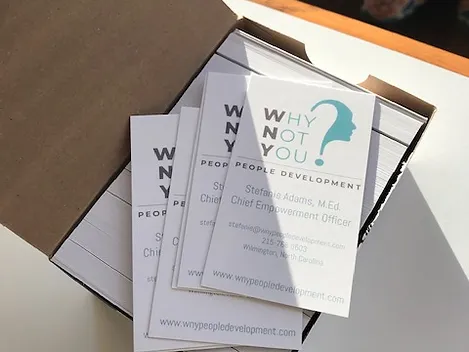
As we head into 2022, you’ve probaby heard of the “Great Resignation”, the “Great Reshuffle”, the “Big Quit”, or any other number of fancy titles to describe the current movement around work.
But what does it all mean, and why is it happening?
Today’s employees want more than a paycheck; they want purpose, empathetic leadership, development, flexibility, and they are willing to leave stability behind to seek companies that demonstrate values and culture that align with what they feel is important for their professional growth.
And competition is fierce.
Job seekers and current employees are in the driver’s seat, and organizations need to step up their game to recruit and retain high quality people; “Free Pizza Friday” just isn’t going to cut it anymore. So what does work?
One effective option…invest in the growth of your people!
Equip employees with support and resources through development to help them grow and succeed. That being said, identifying the right training isn’t so cut and dry; the learning and development (L&D) space offers an array of options, and it’s important that organizations ask themselves a few questions before committing to a single seminar, an “on demand” training software, a full program contract with a third party provider, or anything in between. Consider the following:
WHO ARE MY PEOPLE?
Customization is key.
Hits of the 2000’s, Bachata, Dua Lipa, Motown, and O.A.R. can all be found in my Spotify library; I choose what to listen to based on my mood, not what the radio thinks I should listen to…customization.
Need a new moisturizer? Upload a picture onto an app, answer questions about coverage, age of skin, make up habits, and allergies, and the perfect match is sent to you within 24 hours…customization.
Design your perfect partner on a dating app; can’t promise the profile matches the real person, but it’s worth a shot…customization.
These examples, and countless others, explain why today’s employees expect that their specific needs will be identified and addressed in the workplace; if everything else in life is customizable, why wouldn’t professional development training follow suit?
The L&D industry is working overtime to answer training demand across all industries, driven largely by a post pandemic boom; customization is desired and expected by today’s workforce.
From content development to mode of delivery, there’s a “right” way for all employees to learn, however, you must identify growth opportunities individually. Long gone are the days of “one size fits all” training programs; with the exception of compliance requirements (i.e. safety, sexual harassment) or specific organizational training (i.e. onboarding orientation, culture), being able to connect and customize the most appropriate training program for each employee provides value to the individual, is a more efficient use of time, and a fantastic form of engagement.
Every employee brings varied life experiences, education, motivators, and skills to your organization. Capitalize on those differences; identify what support is necessary to help each person excel in their current role, and prepare them for future roles. Remember, customization is key. Assess strengths, opportunities, and take time to listen to each employee’s short term and long term goals; by aligning training needs with opportunities and modifications that meet an individual where they are, employees will gain a professional portfolio, while building trust and loyalty for the organization.
WHAT DO THEY NEED?
Discuss. Assess. Design.
Determining organizational training needs is simple, right?
Not necessarily.
In my experience, many leaders make decisions about training, without fully unpacking or understanding circumstances; they don’t address the root cause. As a former corporate training manger, I can’t tell you how many times leaders enlisted my help because they needed “team building”; with extended discussion and open ended questions, it was discovered the actual issue was team members not practicing active listening, providing effective feedback to each other, or projects weren’t being completed by deadline because of one employee’s lack of time management skills. The greater umbrella of “team building” may have felt necessary, but many of the issues presented were skill deficits that could be directly addressed with training.
If you’re going to invest in development, make sure you focus on the real issues.
I recommend that leaders use a “KWL” model to start the conversation.
What do you KNOW?
What do you WANT to know?
What have you LEARNED so far?
These three simple questions provide context to assess training needs from an employee’s perspective; marrying what the employee believes they need, with gaps or challenges the leader recognizes, lays the foundation for a training plan. Obviously, high priority needs (i.e. I don’t understand how to use the company software to book client appointments) that impact how an individual completes their job, should rise to the front of the list; important, but not time or role critical needs (i.e. I would like to learn how to facilitate more effective meetings because I’m leading a new project launch in 6 months) should be identified, but would come secondary.
Training is an opportunity to grow your people; designing the plan should be a collaborative process between leader and employee. The sooner you start the dialog, the sooner performance and culture will improve.
HOW WILL IT BE DELIVERED?
Virtual or In-Person? Live or Recorded?
When determing the best mode of delivery for training, you must consider your circumstances. Is your organization fully remote, hybrid, or in person? Is your physical office space an open concept with limited conferencing locations; maybe team members live in varied time zones. Regardless of your situation, there is training available, and I recommend polling your team to learn their preferences.
The first option is live training. Although we’ve all felt some level of zoom fatigue over the past two years, many facilitators are skilled at engaging a real-time audience over virtual platforms. In my opinion as an L&D professional, I don’t think we’ll ever fully replace in-person training (I find it extremely valuable to be in the same room as those I’m working with to listen to responses, observe body language, and team interactions); however, in-person training may not be a preference, or even an option due to budget, safety, or meeting space. When considering live training, virtual or in-person, keep in mind it allows for interaction, response, and immediate feedback. If you team appreciates active engagement, you may want to investigate this as your preferred mode of delivery.
The other option that has gained popularity, especially over the past two years? “On demand” training platforms; virtual training that employees can access on their phone, laptop, tablet, or even on VR, when it is most convenient for their schedule. There are tons of positive aspects, including being able to select from a large menu of development options based on need (remember, customization is key); however, for these courses to be effective, they must be applied. I encourage leaders to follow up with members of their team to find out what they have been learning, why they chose the lessons they did, and how they are being applied.
If your company is embarking on a new training and development journey this year, you have a lot to consider; hopefully, the questions included in this article will prepare you, and assist you in selecting the most appropriate options for your organization or team. However, if you’re feeling overwhelmed, or don’t know where to start, WNY People Development can move you through the process with ease. We can assess, customize, and deliver programming that will support and grow your emerging leaders. Contact us today to schedule a complimentary needs assessment!


